牛津译林版(2019)选择性必修 第一册Unit2 The Universal Language Working the Land-Extended Reading课件 (共34张PPT)
文档属性
| 名称 | 牛津译林版(2019)选择性必修 第一册Unit2 The Universal Language Working the Land-Extended Reading课件 (共34张PPT) |  | |
| 格式 | pptx | ||
| 文件大小 | 7.4MB | ||
| 资源类型 | 教案 | ||
| 版本资源 | 牛津译林版(2019) | ||
| 科目 | 英语 | ||
| 更新时间 | 2023-07-20 17:45:25 | ||
图片预览

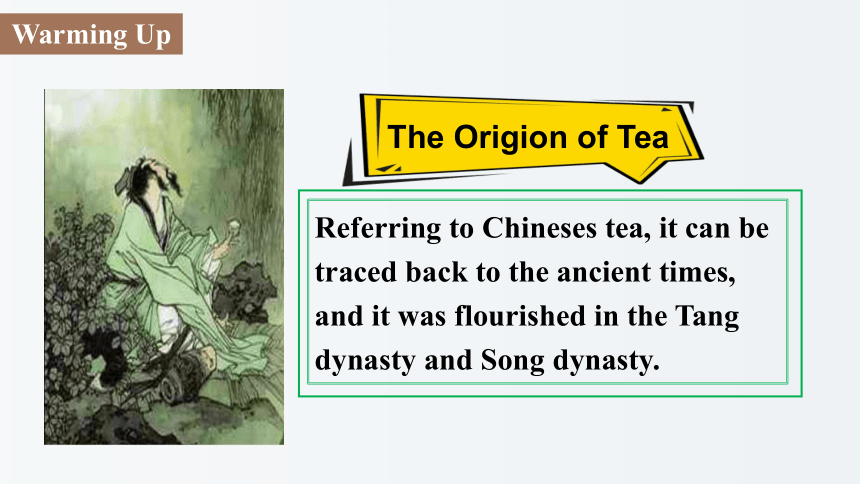

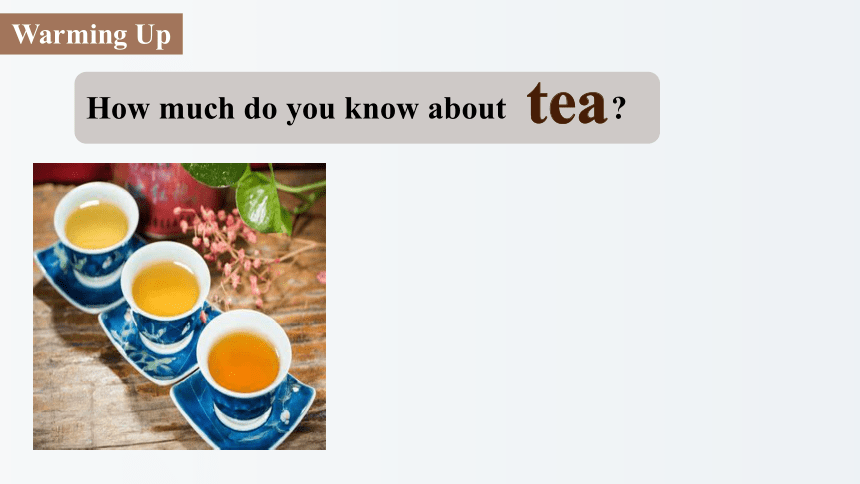
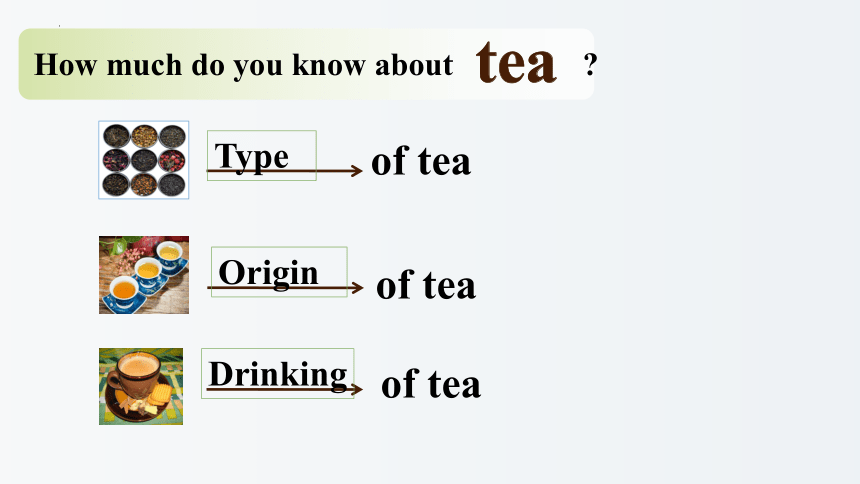
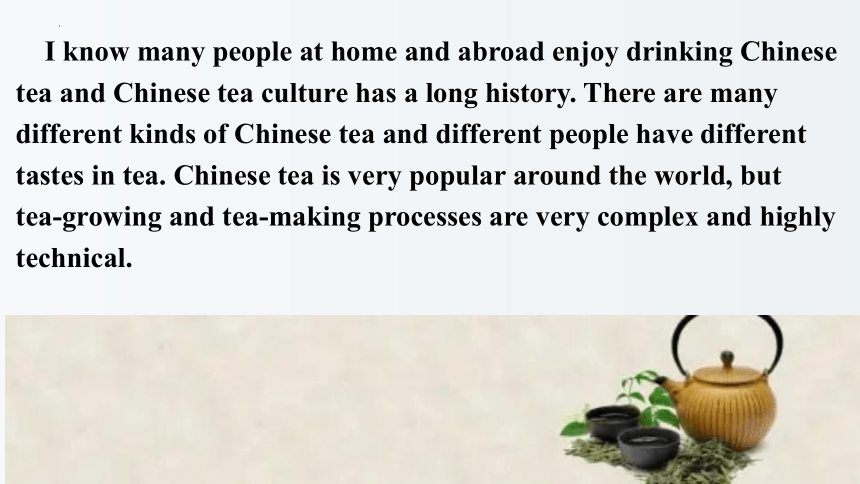
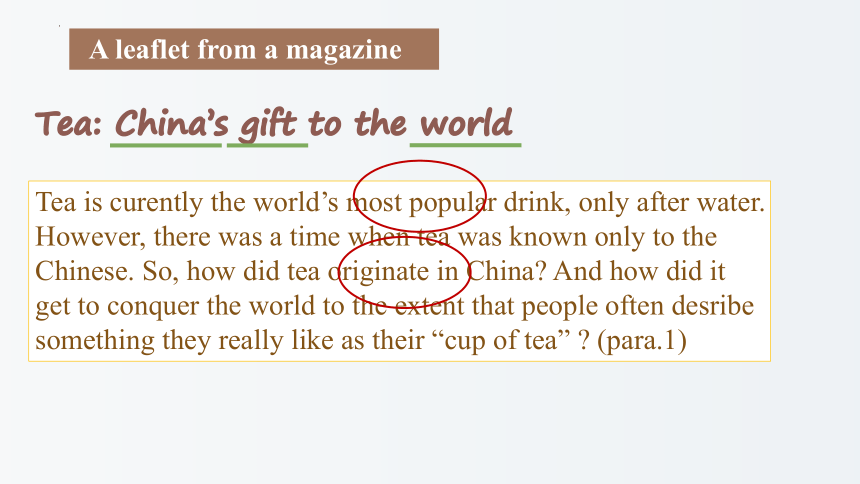
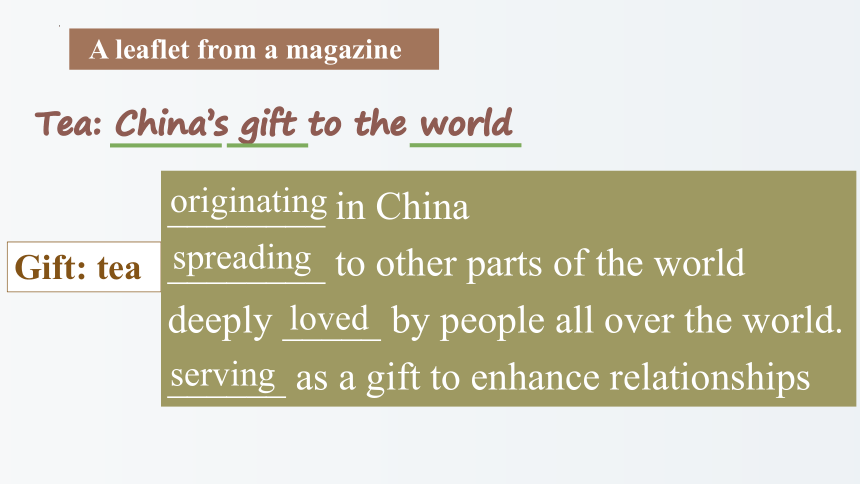


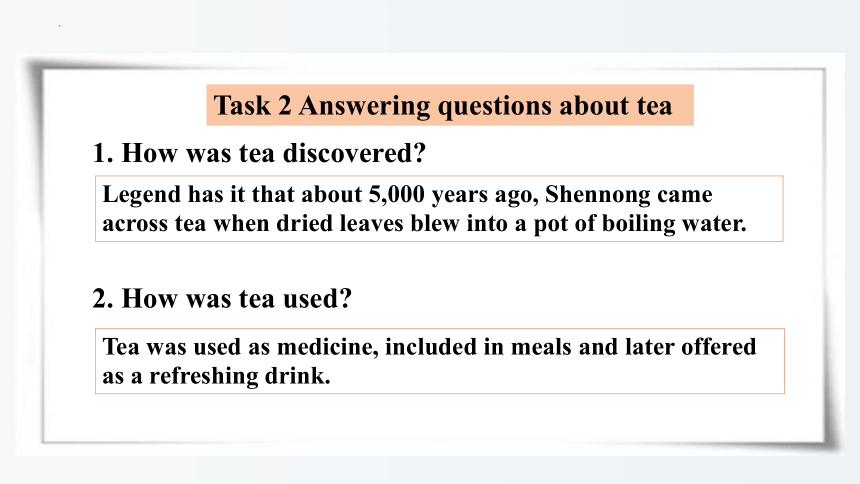
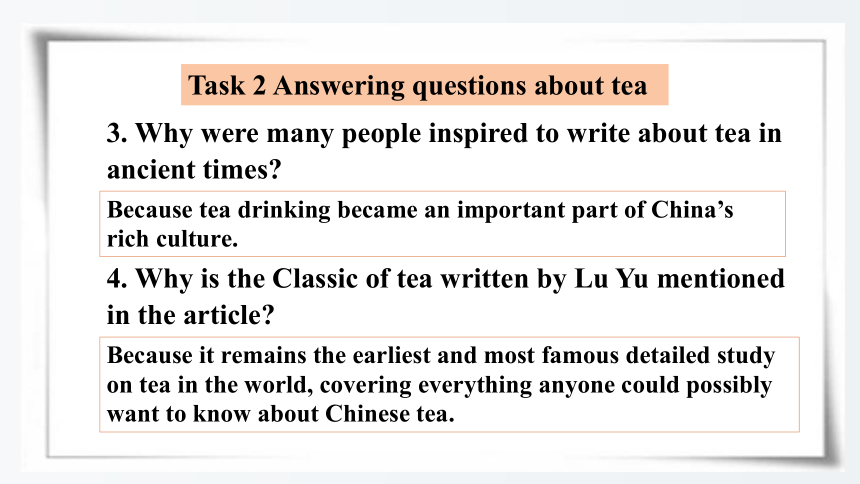
文档简介
(共34张PPT)
新牛津译林版高中英语选修一Unit 2 Working the Land
Extended Reading
The Origion of Tea
Referring to Chineses tea, it can be traced back to the ancient times, and it was flourished in the Tang dynasty and Song dynasty.
Warming Up
A chinese old saying goes: Firewood, rece, oil, salt, sauce, vinegar and tea are the seven necessities to begin a day.
Warming Up
How much do you know about
tea
Warming Up
How much do you know about
tea
of tea
of tea
of tea
Type
Origin
Drinking
I know many people at home and abroad enjoy drinking Chinese
tea and Chinese tea culture has a long history. There are many
different kinds of Chinese tea and different people have different
tastes in tea. Chinese tea is very popular around the world, but
tea-growing and tea-making processes are very complex and highly
technical.
Tea: China’s gift to the world
A leaflet from a magazine
Tea is curently the world’s most popular drink, only after water. However, there was a time when tea was known only to the Chinese. So, how did tea originate in China And how did it get to conquer the world to the extent that people often desribe something they really like as their “cup of tea” (para.1)
Tea: China’s gift to the world
A leaflet from a magazine
Gift: tea
________ in China
________ to other parts of the world
deeply _____ by people all over the world.
______ as a gift to enhance relationships
originating
spreading
loved
serving
Tea: China’s gift to the world
of tea (para.3)
of tea (para.4)
of tea (para.5)
of tea (para.2)
History
Culture
Spread
Power
Task 1 Completing the outline of the leaflet
Task 2 Answering questions about tea
1. How was tea discovered (para.2)
2. How was tea used (para.2)
3. Why were many people inspired to write about tea in ancient times (para.3)
4. Why is the Classic of tea written by Lu Yu mentioned in the article (para.3)
Task 2 Answering questions about tea
1. How was tea discovered
2. How was tea used
Legend has it that about 5,000 years ago, Shennong came across tea when dried leaves blew into a pot of boiling water.
Tea was used as medicine, included in meals and later offered as a refreshing drink.
Task 2 Answering questions about tea
3. Why were many people inspired to write about tea in ancient times
4. Why is the Classic of tea written by Lu Yu mentioned in the article
Because tea drinking became an important part of China’s rich culture.
Because it remains the earliest and most famous detailed study on tea in the world, covering everything anyone could possibly want to know about Chinese tea.
Task 3 The spread of tea (para.4)
spread of tea by road
spread of tea by sea
During the Tang and Song Dynasties, strong Tibetan horses were needed and tea was really popular among the Tibetan people,1 _______________ was born. Porters carrying 2_______________ loads of tea bricks 3___________________ dangerous snow-covered mountain passes in the most terrible weather conditions, to trade Sichuan and Yunnan tea for horses.
Over time, the gift of tea 4 __________Western Asia and Eastern Africa.
As early as the Tang Dynasty, Japanese monks came to study in China and took with them 5 ___________________________ when returning to Japan.
Around the 1600s, tea 6____________ Europe from China by Portuguese and Dutch sea traders.
the Tea Horse Road
back-breaking
made their way through
was further delivered to
tea seeds and tea-making customs
was shipped to
Task 4 Discussion
Why is tea still popular in modern society even the whole world
Part of life
Get refreshed
Prevent certain diseases and maintain health
A way of socializing
Pursue mental peace
…
Task 5 Giving subheadings
From hillside to teacup
subheading 1
subheading 2
subheading 3
Harvesting tea
Processing tea
Drinking tea
To grab the reader's attention
To help them move down the page from one section to the next
To outline the main points of
different sections
Task 6 Completing the card
From hillside to teacup
Growing tea
climate :___1____ soil:___2___
loaction: ___3____ areas:____4__
____5____ tea
what to pick:____6__
when to pick leaves:___7____
____8___ tea
Tea-drinking ways:___9_____
Tea-drinking culture:_10_____
drinking tea
procedures:_____11____
types: green, yellow, white, black and oolong tea
1. warm and humid
2. well-drained
3. steep hillsides
5. Harvesting
4. four distict regions
Task 6 Completing the card
From hillside to teacup
Growing tea
climate :___1____ soil:___2___
loaction: ___3____ areas:____4__
____5____ tea
what to pick:____6__
when to pick leaves:___7____
____8___ tea
procedures:_____9____
types: green, yellow, white, black and oolong tea
Drinking tea
Tea-drinking ways
Tea-drinking culture
7. from early Feb. to late Nov.
8. Processing
9. between two and seven
6. the bud and top leaves
Read the article and decide true (T) or false (F).
1. Tea is currently the world’s second most popular drink.
2. Shennong came across tea when wet leaves blew into a pot of boiling water.
3. Du Fu worte The Classic of Tea.
4. The Tea Horse Road was born to trade horses for tea.
5. Tea drinking is just about refreshing the mind and body.
T
F
F
Tea drinking is not just about refreshing the mind and body but also about appreciating the harmony between man and nature.
T
F
Lu Yu
dried
Task 7
Read the leaflet and decide true (T) or false (F).
6. China boasts many tea-growing areas, which can be divided into three distinct regions.
7. The region south of the Yangtze River produces the most tea in China.
8. The process of turning tea leaves into the tea we love to drink is very easy.
9. Although there are different types of tea, they may be made from a single tea plant.
T
F
four
F
both complicated and highly technical.
T
1. Why is tea still popular in modern society among all age groups
part of life
get refreshed
prevent certain diseases and maintain health
a way of socializing
pursue mental peace
…
Discussion
2. Coffee is also a drink that enjoys popularity around the world. How is it similar to and different from tea
● Popularity
Tea and coffee are very popular beverages around the world.
Discussion
● Health benefits
Both contain caffeine and provide a great energy boost. Both are also beneficial to drinkers’ health when consumed moderately. But they provide different health benefits. Different types of tea offer different health benefits that range from boosting our immune system to protecting us from some cancers and heart disease. Coffee’s health benefits include preventing certain mental diseases that cause cognitive decline.
● History and culture
The origins of tea and coffee are not fully known and there are legends about how they were discovered by accident. The history of tea is much longer than that of coffee: it is commonly believed that tea was discovered about 5,000 years ago and coffee in the 9th century. Preparing and presenting tea could involve more complex procedures than making and drinking coffee, and sometimes a “tea ceremony” is held.
There is something in the nature of tea that leads us into a world of contemplation of life.
/ kɑnt m ple n/ -------Lin Yutang
茶之为物,其特性引领我们进入一个默想的世界。
Aprreciation
到……程度(P1) ____________________
仍然是个谜(P2) ____________________
偶遇;无意中发现;讲得清楚明白 ____________________
激励某人做某事(P3) ____________________
用诗意的语言 ____________________
在……中享有极高的人气(P4) ____________________
前进;成功 ____________________
总结;概述;计算……的总数(P5) ____________________
……的性质/本质 ____________________
人与自然的和谐 ____________________
to the extent
remain something of a mystery
come across
inspire sb to do
in poetic language
enus popularity among
make one’s way
sum up
the nature of
the harmony between man and nature
Expressions(Phrases)
Language Points
1. However, there was a time when tea was known only to the Chinese.
然而,有一段时间,茶只为中国人所知。
there was a time when…
曾经有一段时间……
①There was a time when I had some difficulties in my life.
②There was a time when each teacher spent an hour, one day a week, testing pupils in every subject.
有一段时间我生活中遇到了一些困难。
曾经,每个老师每周都有一天花上一小时对学生的每门功课进行测试。
2. And how did it get to conquer the world to the extent that people often describe something they really like as their “cup of tea”
而它(茶)是如何一步步风靡世界,以至于人们常把自己真正喜欢的东西称为他们的“那杯茶”呢?
(1) to the extent that
达到……的程度,以至于……
①She changed to the extent that you wouldn't recognize her.
②She is still very tired to the extent that she cannot stand up.
她的变化太大了,以至于你会认不出她来。
她在某种程度上还很疲惫,站不起来。
(2) cup of tea
习语,“喜爱的人或事物”
①I know I'm not everyone's cup of tea.
②A nice, quiet evening at home--that's my cup of tea.
我知道自己不是人见人爱。
在家享受一个宁静美好的晚上是我的爱好。
3. Legend has it that about 5,000 years ago, Shennong came across tea when dried leaves blew into a pot of boiling water.
传说大约5000年前,神农发现茶,是因为干树叶被吹进一壶沸水里。
(1)legend has it that
传说……
①Legend has it that the whole village had been cursed by a witch.
②Legend has it that if the groundhog sees his shadow winter will last for six more weeks.
传说整座村庄遭到了巫婆的诅咒。
传说如果土拨鼠看见自己的影子,那冬季就还将持续六周的时间。
(2)came across
偶然发现;碰见
①I came across a group of children playing.
②He's the best opponent I've come across this season, a great player.
我碰到一群正在玩耍的小孩。
他是我本赛季遇到的最出色的对手,一位了不起的运动员。
4. Tea plants grow best in warm, humid regions with well-drained soil.
茶树在温暖、潮湿、气候温和的地区生长得最好排水良好的土壤。
well-drained adj.
排水良好(通畅)的
①Well-drained soil suits the plant best.
②Select a planting location with well-drained sandy soil.
排水性好的土壤最适合于这种植物。
选择排水效果好的砂壤的地方种植。
翻译写列句子。
1. 一个排水良好的土壤是至关重要的。
2. 我一生中从没有遇到过这样的事情。
3. 曾经有段时间,人们可能不好意思一个人去吃饭,但现在不同了。
4. 传说端午节起源于很早很早以前。
I've never come across such an experience in my time.
A well-drained soil is of great importance.
There was a time when people may have felt awkward about asking for a table for one, but those days are over.
Legend has it that the Dragon Boat Festival originated long, long ago.
各个击破
Self-evaluation
Can you use the following words
and expressions correctly
1. there was a time when …
2. to the extent that
3. cup of tea
4. legend has it that
5. came across
6. well-drained
Write a summary of the magazine article. Use the following ideas to help you.
The history of tea
The spread of tea
People’s love of tea
The power of tea
新牛津译林版高中英语选修一Unit 2 Working the Land
Extended Reading
The Origion of Tea
Referring to Chineses tea, it can be traced back to the ancient times, and it was flourished in the Tang dynasty and Song dynasty.
Warming Up
A chinese old saying goes: Firewood, rece, oil, salt, sauce, vinegar and tea are the seven necessities to begin a day.
Warming Up
How much do you know about
tea
Warming Up
How much do you know about
tea
of tea
of tea
of tea
Type
Origin
Drinking
I know many people at home and abroad enjoy drinking Chinese
tea and Chinese tea culture has a long history. There are many
different kinds of Chinese tea and different people have different
tastes in tea. Chinese tea is very popular around the world, but
tea-growing and tea-making processes are very complex and highly
technical.
Tea: China’s gift to the world
A leaflet from a magazine
Tea is curently the world’s most popular drink, only after water. However, there was a time when tea was known only to the Chinese. So, how did tea originate in China And how did it get to conquer the world to the extent that people often desribe something they really like as their “cup of tea” (para.1)
Tea: China’s gift to the world
A leaflet from a magazine
Gift: tea
________ in China
________ to other parts of the world
deeply _____ by people all over the world.
______ as a gift to enhance relationships
originating
spreading
loved
serving
Tea: China’s gift to the world
of tea (para.3)
of tea (para.4)
of tea (para.5)
of tea (para.2)
History
Culture
Spread
Power
Task 1 Completing the outline of the leaflet
Task 2 Answering questions about tea
1. How was tea discovered (para.2)
2. How was tea used (para.2)
3. Why were many people inspired to write about tea in ancient times (para.3)
4. Why is the Classic of tea written by Lu Yu mentioned in the article (para.3)
Task 2 Answering questions about tea
1. How was tea discovered
2. How was tea used
Legend has it that about 5,000 years ago, Shennong came across tea when dried leaves blew into a pot of boiling water.
Tea was used as medicine, included in meals and later offered as a refreshing drink.
Task 2 Answering questions about tea
3. Why were many people inspired to write about tea in ancient times
4. Why is the Classic of tea written by Lu Yu mentioned in the article
Because tea drinking became an important part of China’s rich culture.
Because it remains the earliest and most famous detailed study on tea in the world, covering everything anyone could possibly want to know about Chinese tea.
Task 3 The spread of tea (para.4)
spread of tea by road
spread of tea by sea
During the Tang and Song Dynasties, strong Tibetan horses were needed and tea was really popular among the Tibetan people,1 _______________ was born. Porters carrying 2_______________ loads of tea bricks 3___________________ dangerous snow-covered mountain passes in the most terrible weather conditions, to trade Sichuan and Yunnan tea for horses.
Over time, the gift of tea 4 __________Western Asia and Eastern Africa.
As early as the Tang Dynasty, Japanese monks came to study in China and took with them 5 ___________________________ when returning to Japan.
Around the 1600s, tea 6____________ Europe from China by Portuguese and Dutch sea traders.
the Tea Horse Road
back-breaking
made their way through
was further delivered to
tea seeds and tea-making customs
was shipped to
Task 4 Discussion
Why is tea still popular in modern society even the whole world
Part of life
Get refreshed
Prevent certain diseases and maintain health
A way of socializing
Pursue mental peace
…
Task 5 Giving subheadings
From hillside to teacup
subheading 1
subheading 2
subheading 3
Harvesting tea
Processing tea
Drinking tea
To grab the reader's attention
To help them move down the page from one section to the next
To outline the main points of
different sections
Task 6 Completing the card
From hillside to teacup
Growing tea
climate :___1____ soil:___2___
loaction: ___3____ areas:____4__
____5____ tea
what to pick:____6__
when to pick leaves:___7____
____8___ tea
Tea-drinking ways:___9_____
Tea-drinking culture:_10_____
drinking tea
procedures:_____11____
types: green, yellow, white, black and oolong tea
1. warm and humid
2. well-drained
3. steep hillsides
5. Harvesting
4. four distict regions
Task 6 Completing the card
From hillside to teacup
Growing tea
climate :___1____ soil:___2___
loaction: ___3____ areas:____4__
____5____ tea
what to pick:____6__
when to pick leaves:___7____
____8___ tea
procedures:_____9____
types: green, yellow, white, black and oolong tea
Drinking tea
Tea-drinking ways
Tea-drinking culture
7. from early Feb. to late Nov.
8. Processing
9. between two and seven
6. the bud and top leaves
Read the article and decide true (T) or false (F).
1. Tea is currently the world’s second most popular drink.
2. Shennong came across tea when wet leaves blew into a pot of boiling water.
3. Du Fu worte The Classic of Tea.
4. The Tea Horse Road was born to trade horses for tea.
5. Tea drinking is just about refreshing the mind and body.
T
F
F
Tea drinking is not just about refreshing the mind and body but also about appreciating the harmony between man and nature.
T
F
Lu Yu
dried
Task 7
Read the leaflet and decide true (T) or false (F).
6. China boasts many tea-growing areas, which can be divided into three distinct regions.
7. The region south of the Yangtze River produces the most tea in China.
8. The process of turning tea leaves into the tea we love to drink is very easy.
9. Although there are different types of tea, they may be made from a single tea plant.
T
F
four
F
both complicated and highly technical.
T
1. Why is tea still popular in modern society among all age groups
part of life
get refreshed
prevent certain diseases and maintain health
a way of socializing
pursue mental peace
…
Discussion
2. Coffee is also a drink that enjoys popularity around the world. How is it similar to and different from tea
● Popularity
Tea and coffee are very popular beverages around the world.
Discussion
● Health benefits
Both contain caffeine and provide a great energy boost. Both are also beneficial to drinkers’ health when consumed moderately. But they provide different health benefits. Different types of tea offer different health benefits that range from boosting our immune system to protecting us from some cancers and heart disease. Coffee’s health benefits include preventing certain mental diseases that cause cognitive decline.
● History and culture
The origins of tea and coffee are not fully known and there are legends about how they were discovered by accident. The history of tea is much longer than that of coffee: it is commonly believed that tea was discovered about 5,000 years ago and coffee in the 9th century. Preparing and presenting tea could involve more complex procedures than making and drinking coffee, and sometimes a “tea ceremony” is held.
There is something in the nature of tea that leads us into a world of contemplation of life.
/ kɑnt m ple n/ -------Lin Yutang
茶之为物,其特性引领我们进入一个默想的世界。
Aprreciation
到……程度(P1) ____________________
仍然是个谜(P2) ____________________
偶遇;无意中发现;讲得清楚明白 ____________________
激励某人做某事(P3) ____________________
用诗意的语言 ____________________
在……中享有极高的人气(P4) ____________________
前进;成功 ____________________
总结;概述;计算……的总数(P5) ____________________
……的性质/本质 ____________________
人与自然的和谐 ____________________
to the extent
remain something of a mystery
come across
inspire sb to do
in poetic language
enus popularity among
make one’s way
sum up
the nature of
the harmony between man and nature
Expressions(Phrases)
Language Points
1. However, there was a time when tea was known only to the Chinese.
然而,有一段时间,茶只为中国人所知。
there was a time when…
曾经有一段时间……
①There was a time when I had some difficulties in my life.
②There was a time when each teacher spent an hour, one day a week, testing pupils in every subject.
有一段时间我生活中遇到了一些困难。
曾经,每个老师每周都有一天花上一小时对学生的每门功课进行测试。
2. And how did it get to conquer the world to the extent that people often describe something they really like as their “cup of tea”
而它(茶)是如何一步步风靡世界,以至于人们常把自己真正喜欢的东西称为他们的“那杯茶”呢?
(1) to the extent that
达到……的程度,以至于……
①She changed to the extent that you wouldn't recognize her.
②She is still very tired to the extent that she cannot stand up.
她的变化太大了,以至于你会认不出她来。
她在某种程度上还很疲惫,站不起来。
(2) cup of tea
习语,“喜爱的人或事物”
①I know I'm not everyone's cup of tea.
②A nice, quiet evening at home--that's my cup of tea.
我知道自己不是人见人爱。
在家享受一个宁静美好的晚上是我的爱好。
3. Legend has it that about 5,000 years ago, Shennong came across tea when dried leaves blew into a pot of boiling water.
传说大约5000年前,神农发现茶,是因为干树叶被吹进一壶沸水里。
(1)legend has it that
传说……
①Legend has it that the whole village had been cursed by a witch.
②Legend has it that if the groundhog sees his shadow winter will last for six more weeks.
传说整座村庄遭到了巫婆的诅咒。
传说如果土拨鼠看见自己的影子,那冬季就还将持续六周的时间。
(2)came across
偶然发现;碰见
①I came across a group of children playing.
②He's the best opponent I've come across this season, a great player.
我碰到一群正在玩耍的小孩。
他是我本赛季遇到的最出色的对手,一位了不起的运动员。
4. Tea plants grow best in warm, humid regions with well-drained soil.
茶树在温暖、潮湿、气候温和的地区生长得最好排水良好的土壤。
well-drained adj.
排水良好(通畅)的
①Well-drained soil suits the plant best.
②Select a planting location with well-drained sandy soil.
排水性好的土壤最适合于这种植物。
选择排水效果好的砂壤的地方种植。
翻译写列句子。
1. 一个排水良好的土壤是至关重要的。
2. 我一生中从没有遇到过这样的事情。
3. 曾经有段时间,人们可能不好意思一个人去吃饭,但现在不同了。
4. 传说端午节起源于很早很早以前。
I've never come across such an experience in my time.
A well-drained soil is of great importance.
There was a time when people may have felt awkward about asking for a table for one, but those days are over.
Legend has it that the Dragon Boat Festival originated long, long ago.
各个击破
Self-evaluation
Can you use the following words
and expressions correctly
1. there was a time when …
2. to the extent that
3. cup of tea
4. legend has it that
5. came across
6. well-drained
Write a summary of the magazine article. Use the following ideas to help you.
The history of tea
The spread of tea
People’s love of tea
The power of tea
同课章节目录
- Unit 1 Food matters
- Welcome to the unit
- Reading
- Grammar and usage
- Integrated skills
- Extended reading
- Project
- Unit 2 The Universal Language
- Welcome to the unit
- Reading
- Grammar and usage
- Integrated skills
- Extended reading
- Project
- Unit 3 The art of painting
- Welcome to the unit
- Reading
- Grammar and usage
- Integrated skills
- Extended reading
- Project
- Unit 4 Exploring poetry
- Welcome to the unit
- Reading
- Grammar and usage
- Integrated skills
- Extended reading
- Project
